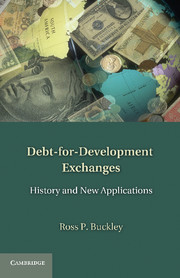Book contents
- Frontmatter
- Contents
- Acknowledgments
- List of Contributors
- Introduction: A Productive Partnership between Civil Society and the Academy
- Part I Types of Exchanges and Their Development over Time
- Part II Exchanges by Donor Countries
- Part III Critiques of Exchanges
- Part IV Innovative Applications of Exchanges
- 15 Farmer-Managed Natural Regeneration: A Land Rehabilitation Technique Well Adapted to Funding by Exchanges
- 16 Restoring Mangroves in the Philippines
- 17 Poverty Reduction through Social Protection: A Potential Form of Debt-for-Development Exchange
- 18 Climate Change Adaptation Exchanges: An Exploration of the Possibilities and Risks
- 19 Climate Change and Food Security: Building Resilience by Means of Climate Field Schools
- 20 Debt-for-Security Exchanges
- 21 Promoting Good Governance through ICT Systems: Improving Transparency and Reducing Corruption
- 22 Using Debt Exchanges to Enhance Public Accountability to Citizens
- Conclusion
- Index
- References
16 - Restoring Mangroves in the Philippines
Published online by Cambridge University Press: 01 June 2011
- Frontmatter
- Contents
- Acknowledgments
- List of Contributors
- Introduction: A Productive Partnership between Civil Society and the Academy
- Part I Types of Exchanges and Their Development over Time
- Part II Exchanges by Donor Countries
- Part III Critiques of Exchanges
- Part IV Innovative Applications of Exchanges
- 15 Farmer-Managed Natural Regeneration: A Land Rehabilitation Technique Well Adapted to Funding by Exchanges
- 16 Restoring Mangroves in the Philippines
- 17 Poverty Reduction through Social Protection: A Potential Form of Debt-for-Development Exchange
- 18 Climate Change Adaptation Exchanges: An Exploration of the Possibilities and Risks
- 19 Climate Change and Food Security: Building Resilience by Means of Climate Field Schools
- 20 Debt-for-Security Exchanges
- 21 Promoting Good Governance through ICT Systems: Improving Transparency and Reducing Corruption
- 22 Using Debt Exchanges to Enhance Public Accountability to Citizens
- Conclusion
- Index
- References
Summary
INTRODUCTION
The Philippines' economic situation is quite bleak. Its total external debt was US$65.8 billion at the end of 2008, up from US$58 billion in 2000. Poverty has increased in the past 30 years, with 45% of the population living on less than US$2 per day. The Philippines owed Australia A$66.6 million in 2009, down significantly from A$493 million in 2003. Most of this debt was incurred more than 10 years ago as a result of the Development Import Finance Facility (DIFF) scheme. DIFF was a soft-loan scheme to fund purchases from Australian companies by recipient governments and has been criticised by Australia's former Treasurer, Peter Costello, as a ‘subsidy paid to domestic businesses’. The Australian economy has thus already benefited from the enhanced exports.
In the mid-2000s the Philippines took substantial steps to reduce its external sovereign debt. President Arroyo implemented fiscal and monetary policies that helped to control inflation and lift the nation's debt rating. These included raising the Value Added Tax (VAT) from 10% to 12% in February 2006, which was intended to bring in additional revenue of PHP 75 billion in 2006, and extending the VAT to energy products in November 2005. The VAT was intended to lift the ratio of tax to gross domestic product (GDP) and provide greater revenue for the government.
- Type
- Chapter
- Information
- Debt-for-Development ExchangesHistory and New Applications, pp. 199 - 208Publisher: Cambridge University PressPrint publication year: 2011



